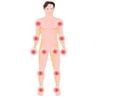Arthritis in the knee is associated with a common fallout of one leg being longer than the other, a study has revealed.
Arthritis in the knee is associated with a common fallout of one leg being longer than the other, a study has revealed.
Developing early strategies for treatment may be possible, believes Derek Cooke, Queen's University adjunct professor and a co-author of the study."Most pediatricians adopt a 'wait and see' attitude for children with limb misalignment when they're growing," says Dr. Cooke. "If we can spot factors creating changes in alignment early in bone development, theoretically we could stop or slow down the progression of osteoarthritis."
To reach the conclusion, data was collected using x-ray images from more than 3,000 adults aged 50 to 79 who either had knee pain or risk factors for knee osteoarthritis as a part of the Multi Centre Osteoarthritis Study (MOST). Subjects were reassessed after a 30-month period and the researchers found that osteoarthritic changes in the knee were most significant in individuals with pronounced (more than 1 cm) leg length inequality, the shorter leg being most affected.
Leg length inequality is difficult to detect. A small leg length differential - 1 cm or less - can be corrected with a shoe insert, while a bigger one can be corrected with surgery. But because the condition often goes undiagnosed, many people don't realize they have a leg length differential until they're diagnosed with osteoarthritis.
Arthritis in the knees can cause pain, swelling and stiffness, and limit mobility.
Source-ANI
SAV














